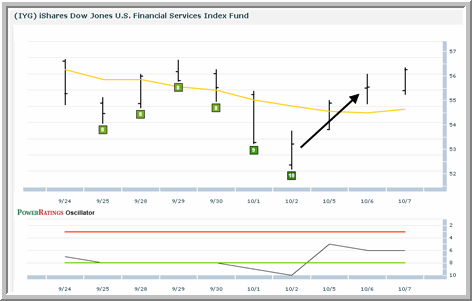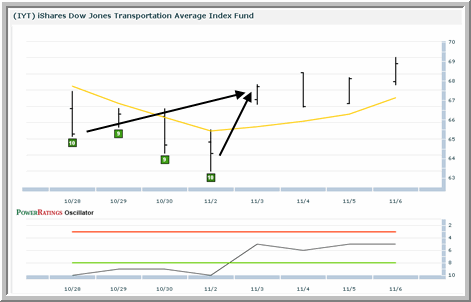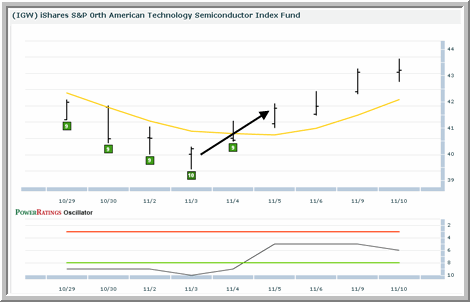ETF PowerRatings: Strategies for Trading Top Rated ETFs
Our ETF PowerRatings rating system rates exchange-traded funds (ETFs) on a scale of 1 to 10. The lowest rated ETFs, those with ETF PowerRatings of 1 or 2, are ETFs that are best avoided – or used as part of short selling trading strategies. But the highest rated ETFs, those that have earned ETF PowerRatings of 8, 9 or 10 are the kind of exchange-traded funds that high probability traders are willing to wait days for.
Why? Because trading strategies that use our highest rated ETFs – those ETFs earning at least a PowerRating of 8, but preferably 9 or 10 – will be trading funds that have made significant short term gains more than 75% of the time. Our highest rated exchange-traded funds – those ETFs with ETF PowerRatings of 10 – have produced strong, short-term gains nearly 80% of the time.
Click here to find out more about our ETF PowerRatings!
So how do short term traders take advantage of top-rated ETF PowerRatings funds?
Buy Top Rated ETFs with PowerRatings of 8, 9 or 10

One day after earning an ETF PowerRating upgrade to 10, the iShares Dow Jones U.S. Financial Services Index ETF
(
IYG |
Quote |
Chart |
News |
PowerRating) was rallying into strength and providing a high probability gain of more than 3% for ETF PowerRatings traders.
The best time to buy a high PowerRating ETF is after that ETF has pulled back. Our ETF PowerRatings make this easy, giving ETFs higher ratings as they pullback and become more oversold. As a general rule, the greater the pullback, the more oversold the ETF and the higher the ETF PowerRating.
Country and Equity Index ETFs Outperform Sector and Commodity ETFs
We have tested over a hundred ETFs since 2003, backtests that involved thousands of simulated ETF trades. Not only did this backtesting produce our ETF PowerRatings system, but also it helped us learn something about how well different types of exchange-traded fund react during and after pulling back.

ETF PowerRatings traders had two excellent opportunities to buy shares of the iShares Dow Jones Transportation Average Index ETF
(
IYT |
Quote |
Chart |
News |
PowerRating) after it earned our highest rating of 10.
In short, we found that ETFs that are based on national stock markets, such as the stock market of Brazil or China, as well as domestic equity index ETFs, tend to outperform ETFs that are based on sectors or commodities. There are a number of reasons for this, but the most essential one is that country and equity index ETFs tend to be more diversified than sector or commodity ETFs. This inherent diversification tends to help country and equity index ETFs move more consistently and reliably between overbought and oversold conditions.
This doesn’t mean that sector ETFs cannot provide excellent opportunities for ETF traders. I’ve included in this report the charts of three sector ETFs over the past month that earned top ETF PowerRatings of 10. But all things equal, trading strategies that start with country and equity index ETFs first, sector ETFs second and commodity ETFs last are the kind of high probability ETF trading strategies short term traders can believe in.
Exit on Strength
Larry Connors uses the phrase “buy the selling and sell the buying” to sum up what high probability trading – and high probability trading strategies using ETF PowerRatings – are all about.

A gain of nearly 4% for ETF PowerRatings traders who picked up shares of the iShares S&P North American Technology Semiconductor Index Fund ETF
(
IGW |
Quote |
Chart |
News |
PowerRating) after the ETF earned an upgrade to 10.
What this phrase means is that trading strategies based on buying markets such as ETFs on pullback call for exiting positions when those markets recover. As ETF PowerRatings traders, we are always looking to buy markets on sale and to sell those markets as buyers return and begin bidding prices higher.
If you’ve been curious about trading ETFs, but have been looking for trading strategies you can trust, then give our ETF PowerRatings a try. Backed up by thousands of simulated ETF trades going back to 2003, ETF PowerRatings are the only ETF rating system that provides this level of quantified results.
Give our ETF PowerRatings a try for seven days and see what a quantified, professional approach to short-term trading in exchange-traded funds can do for you. Click here to launch your free, 7-day trial today.
David Penn is Editor in Chief at TradingMarkets.com.
